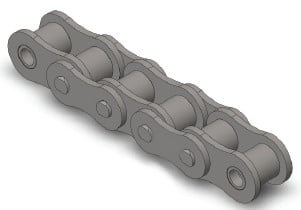Roller chains are 1 from the most efficient and expense eff ective solutions to transmit mechanical electrical power involving shafts. They operate in excess of a broad array of speeds, manage big operating loads, have really smaller vitality losses and therefore are commonly inexpensive compared with other techniques
of transmitting power. Profitable variety involves following many somewhat simple actions involving algebraic calculation along with the utilization of horsepower and services aspect tables.
For almost any given set of drive circumstances, there are a variety of achievable chain/sprocket confi gurations which will effectively operate. The designer for that reason should be conscious of quite a few primary selection principles that when applied the right way, aid balance overall drive overall performance and expense. By following the ways outlined within this section designers ought to be ready to generate selections that meet the specifications of your drive and are price eff ective.
Basic Roller Chain Drive Ideas
? The proposed number of teeth for the small sprocket is 15. The minimum is 9 teeth – smoother operation is obtained with far more teeth.
? The encouraged greatest quantity of teeth to the substantial sprocket is 120. Note that  while more teeth allows for smoother operation having as well quite a few teeth prospects to chain jumping off the sprocket following a rather small quantity of chain elongation as a consequence of wear – That’s chains having a pretty big variety of teeth accommodate significantly less wear prior to the chain will no longer wrap all around them properly.
while more teeth allows for smoother operation having as well quite a few teeth prospects to chain jumping off the sprocket following a rather small quantity of chain elongation as a consequence of wear – That’s chains having a pretty big variety of teeth accommodate significantly less wear prior to the chain will no longer wrap all around them properly.
? Speed ratios must be 7:one or significantly less (optimum) and never better
than 10:1. For bigger ratios the use of a number of chain reductions is suggested.
? The advised minimal wrap in the modest sprocket is 120°.
? The proposed center distance in between shafts is 30-50 pitches of chain. You’ll find two exceptions to this as follows:
1. The center distance have to be greater compared to the sum on the outdoors diameters from the driver and driven sprockets to prevent interference.
two. For velocity ratios higher than 3:1 the center distance should not be less than the outdoors diameter of the big sprocket minus the outdoors diameter of the small sprocket to assure a minimum 120° wrap around the little sprocket.
